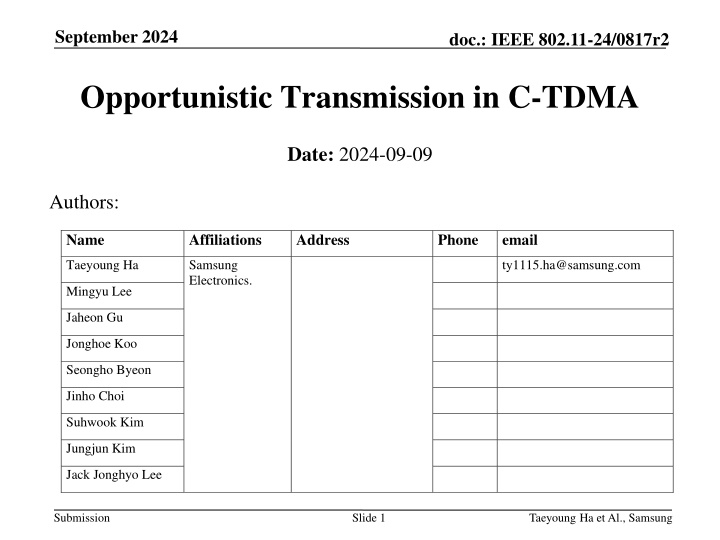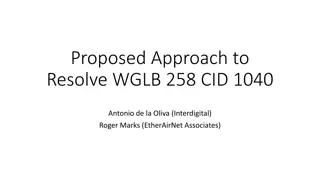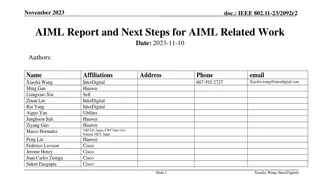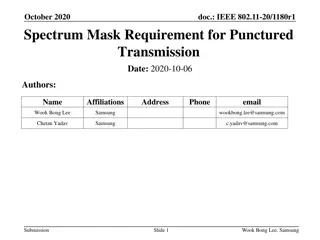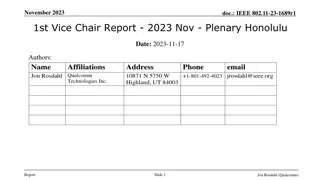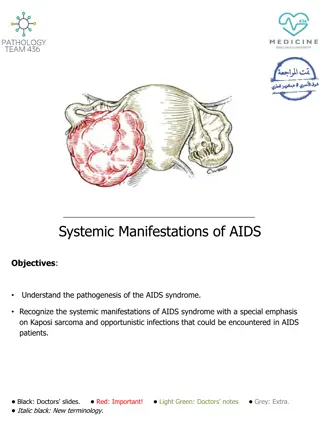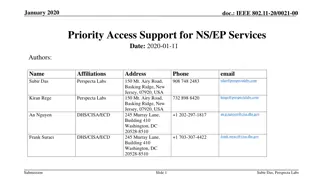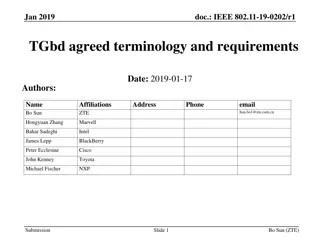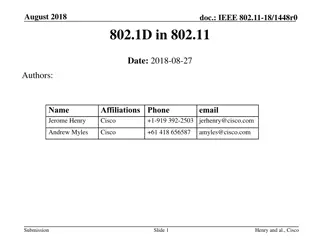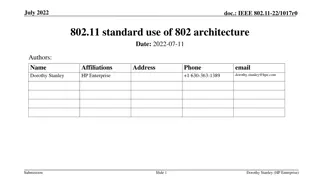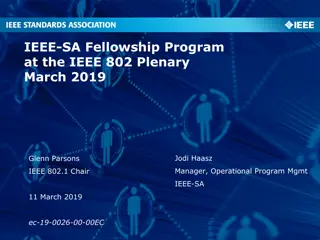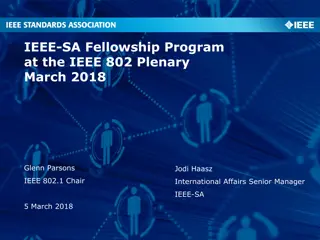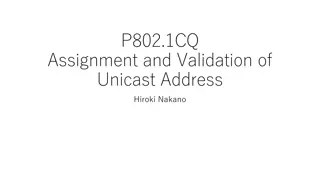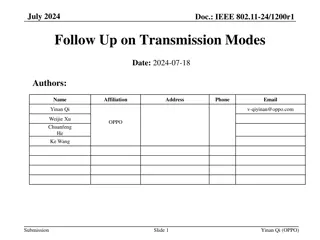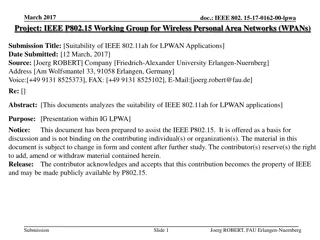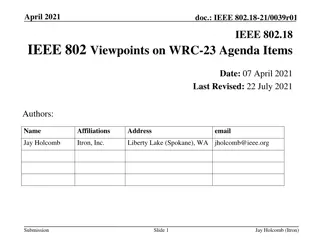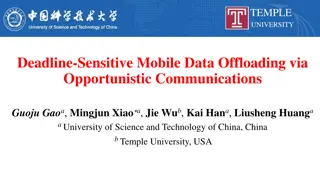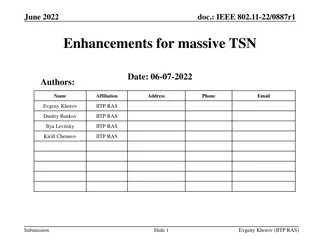Opportunistic Transmission in IEEE 802.11-24
This document discusses opportunistic transmission in IEEE 802.11-24, focusing on the proposal for transmission procedures within shared TXOP durations. It outlines the options for implementation and details operational conditions. Additionally, it explores the concept of opportunistic transmission in C-TDMA and its potential collision implications.
Download Presentation

Please find below an Image/Link to download the presentation.
The content on the website is provided AS IS for your information and personal use only. It may not be sold, licensed, or shared on other websites without obtaining consent from the author.If you encounter any issues during the download, it is possible that the publisher has removed the file from their server.
You are allowed to download the files provided on this website for personal or commercial use, subject to the condition that they are used lawfully. All files are the property of their respective owners.
The content on the website is provided AS IS for your information and personal use only. It may not be sold, licensed, or shared on other websites without obtaining consent from the author.
E N D
Presentation Transcript
September 2024 doc.: IEEE 802.11-24/0817r2 Opportunistic Transmission in C-TDMA Date: 2024-09-09 Authors: Name Affiliations Address Phone email Taeyoung Ha Samsung Electronics. ty1115.ha@samsung.com Mingyu Lee Jaheon Gu Jonghoe Koo Seongho Byeon Jinho Choi Suhwook Kim Jungjun Kim Jack Jonghyo Lee Submission Slide 1 Taeyoung Ha et Al., Samsung
September 2024 doc.: IEEE 802.11-24/0817r2 Introduction In [1], allowing the transmission of AP within the duration of shared TXOP when the AP is hidden to the shared AP is proposed There were two options to carry out this procedures Option 1: Using the NAVTimeout Option 2: Change the duration field of MU-RTS TXS TF In this contribution, more detail operations and conditions for conducting this procedures are proposed Submission Slide 2 Taeyoung Ha et Al., Samsung
September 2024 Recap: Opportunistic Transmission in C-TDMA In [1], opportunistic transmission (OT) in C-TDMA is proposed Sharing AP (AP 2) shares its TXOP to Shared AP (AP 3) OT AP (AP 1) and Shared AP (AP 3) are hidden to each other If transmission of OT AP (i.e., AP 1 STA 1) do not affect on the transmission of shared AP (i.e., AP 3 STA 6), then the transmission of OT AP (i.e., AP 1 STA 1) is allowed within the shared TXOP duration doc.: IEEE 802.11-24/0817r2 AP 2 (Sharing AP) TXS STA 3 STA 6 AP 1 (OT AP) AP 3 STA 5 (Shared AP) STA 1 STA 2 STA 4 Submission Slide 3 Taeyoung Ha et Al., Samsung
September 2024 Recap: Opportunistic Transmission in C-TDMA However, this opportunistic transmission in C-TDMA can be result in the collision at the sharing AP when the shared AP returns its TXOP to the sharing AP. This is because the OT AP and the sharing AP are not hidden to each other. doc.: IEEE 802.11-24/0817r2 AP2's Acquired TXOP Shared TXOP MU- RTS TXS TF Data AP 2 (Sharing AP) Collision CF- END CTS Data AP 3 (Shared AP) Data AP 1 (OT AP) Ack STA 6 STA 1 Submission Slide 4 Taeyoung Ha et Al., Samsung
September 2024 doc.: IEEE 802.11-24/0817r2 Recap: Framework for C-TDMA Frameworks for C-TDMA operations were proposed in [2]-[4] There are two types of C-TDMA operations (i.e., C-TDMA operation for periodic or aperiodic traffic) During the C-TDMA configuration setting phase, Configurations of C- TDMA operation (e.g., capabilities of each AP, periodic traffic information (e.g., SCS)) can be set among APs This can be the part of the M-AP configurations setting procedure Information about periodic traffics can be shared among the APs during the C- TDMA configuration setting procedure By using information obtained in this phase, the amount of periodic traffic can be predicted Operation (e.g., Periodic) For long-term For short-term Operation (e.g., aperiodic) For short-term Operation (e.g., aperiodic) AP 1 C-TDMA Operation for periodic traffic C-TDMA Operation for aperiodic traffic C-TDMA Operation for periodic traffic C-TDMA Operation for periodic traffic C-TDMA Operation for aperiodic traffic C-TDMA set Configuration Pre C-TDMA info exchange Pre C-TDMA info exchange ... ... ... ... ... ... AP n Submission Slide 5 Taeyoung Ha et Al., Samsung
September 2024 doc.: IEEE 802.11-24/0817r2 Recap: Framework for C-TDMA During the pre C-TDMA information exchange procedure, information /signaling for the short-term C-TDMA operation (e.g., request the C- TDMA resource) may be conducted The possible solution for this procedure can be exchange of BSR or NFR By conducting this procedure, information of aperiodic traffic can be obtained For long-term Operation (e.g., Periodic) For short-term Operation (e.g., aperiodic) For short-term Operation (e.g., aperiodic) AP 1 C-TDMA Operation for periodic traffic C-TDMA Operation for aperiodic traffic C-TDMA Operation for periodic traffic C-TDMA Operation for periodic traffic C-TDMA Operation for aperiodic traffic C-TDMA set Configuration Pre C-TDMA info exchange Pre C-TDMA info exchange ... ... ... ... ... ... AP n Submission Slide 6 Taeyoung Ha et Al., Samsung
September 2024 doc.: IEEE 802.11-24/0817r2 TXOP Return Operation Based on the prerequisite, the sharing AP may predict the amount of TXOP for shared AP before C-TDMA operation If amount of TXOP is well predicted, the TXOP return procedure may not be needed In addition, support of TXOP return operation can be optional as 11be (i.e., TXOP Return Support In Triggered TXOP Sharing Mode 2 in 11be) Submission Slide 7 Taeyoung Ha et Al., Samsung
September 2024 doc.: IEEE 802.11-24/0817r2 Hidden Node Problem in C-TDMA Due to the OBSS Transmission, the transmission of Shared AP may be unsuccessful which can be result in the waste of resources For example, when Sharing AP (AP 2) shares its TXOP to Shared AP (AP 3), and the shared AP transmits data to the STA in its BSS (STA 6). However there is OBSS transmission around the STA (STA 6), the STA (STA 6) can not receive the data from Shared AP (AP 3) AP 2 (Sharing AP) OBSS TXS Collision Transmission STA 3 STA 6 AP 3 STA 5 (Shared AP) STA 4 Submission Slide 8 Taeyoung Ha et Al., Samsung
September 2024 doc.: IEEE 802.11-24/0817r2 Control Frame Exchange Control frame exchange (e.g., RTS-CTS) may prevent the hidden node problem in C-TDMA Example) Basic NAV of STA 6 is set by the OBSS transmission When AP 3 transmits a control frame (e.g., RTS) to the STA 6, but STA 6 can not reply due to the Basic NAV, therefore AP 3 may not transmit a data frame to the STA 6 AP 3 may use the shared TXOP to other STAs Acquired TXOP Shared TXOP MU- RTS TXS TF AP 2 (Sharing AP) AP 2 CTS RTS Data (Sharing AP) AP 3 OBSS TXS (Shared AP) Transmission STA 3 STA 6 AP 3 STA 5 CTS (Shared AP) Basic NAV (Set by OBSS) STA 4 STA 6 Submission Slide 9 Taeyoung Ha et Al., Samsung
September 2024 doc.: IEEE 802.11-24/0817r2 Opportunistic Transmission in C-TDMA Network Topology and Assumption Sharing AP (AP 2) shares its TXOP to Shared AP (AP3) OT AP (AP 1) and Shared AP (AP 3) are hidden to each other Before starting the data transmission in the shared TXOP, Control frame exchange (e.g., RTS-CTS) is conducted to prevent the hidden node problem Return of the shared TXOP is not allowed AP2's Acquired TXOP Shared TXOP MU- RTS TXS TF AP 2 (Sharing AP) Cont rol CTS Data AP 3 (Shared AP) Cont rol Data AP 1 (OT AP) M-APNAVTimeout AP 2 (Sharing AP) Ack Ack TXS STA 6 STA 3 STA 6 AP 1 (OT AP) AP 3 STA 5 (Shared AP) STA 1 Ack ACK STA 2 STA 1 STA 4 Submission Slide 10 Taeyoung Ha et Al., Samsung
September 2024 doc.: IEEE 802.11-24/0817r2 Opportunistic Transmission in C-TDMA Proposed operation of opportunistic transmission in C-TDMA After a OT AP (i.e., NOT the shared AP) receives the TXOP sharing message (e.g., MU-RTS TXS TF) from the sharing AP, the OT AP reset its NAV after duration of M- APNAVTimeout only when the return of TXOP is not allowed M-APNAVTimeout value can be (3SIFS + CTS + Control + Resp. of Control) (Different from current NAVTimeout value) If the NAV of OT AP is reset after M- APNAVTimeout , the OT AP tries to do EDCA access and transmit data within the duration of shared TXOP AP2's Acquired TXOP Shared TXOP MU- RTS TXS TF AP 2 (Sharing AP) Cont rol CTS Data AP 3 (Shared AP) Cont rol Data AP 1 (OT AP) M-APNAVTimeout AP 2 (Sharing AP) Ack Ack TXS STA 6 STA 3 STA 6 AP 1 (OT AP) AP 3 STA 5 (Shared AP) STA 1 Ack ACK STA 2 STA 1 STA 4 Submission Slide 11 Taeyoung Ha et Al., Samsung
September 2024 doc.: IEEE 802.11-24/0817r2 Hidden Node Problem in OT Due to the OT, the transmission of Shared AP may be unsuccessful For example, if the shared AP (AP 3) transmits data frames to the STA in its BSS (STA 5), OT AP (AP 1) may start its transmission because OT AP (AP 1) can not detect the transmission of shared AP (AP 3). The transmission of OT AP (AP 1) may result in the collision at the STA associated with the shared AP (STA 5). AP 2 (Sharing AP) TXS STA 3 STA 6 AP 1 (OT AP) AP 3 STA 5 Collision (Shared AP) STA 1 STA 2 STA 4 Submission Slide 12 Taeyoung Ha et Al., Samsung
September 2024 doc.: IEEE 802.11-24/0817r2 Control Frame Exchange Control frame exchange (e.g., RTS-CTS) may prevent the hidden node problem in OT For example, if Shared AP (AP 3) transmits a data frame to the STA in its BSS (STA 5) after the control frame exchange, NAV reset procedure (after M- APNAVTimeout) at OT AP (AP 1) failed due to the control frame exchange procedure in the shared TXOP. AP2's Acquired TXOP Shared TXOP MU- RTS TXS TF AP 2 (Sharing AP) Cont rol CTS Data AP 2 AP 3 (Sharing AP) (Shared AP) TXS STA 3 STA 6 AP 1 (OT AP) AP 3 STA 5 M-APNAVTimeout Failed AP 1 (OT AP) (Shared AP) NAV set by the Ack of STA 5 STA 1 STA 2 STA 4 Ack Ack STA 5 Submission Slide 13 Taeyoung Ha et Al., Samsung
September 2024 doc.: IEEE 802.11-24/0817r2 Summary Opportunistic transmission in C-TDMA is proposed in limited condition to enhance the medium efficiency Opportunistic transmission is available only when the return of shared TXOP in C-TDMA is not used Control frame exchange is highly recommended in C-TDMA operation to prevent the hidden node problems Remaining Problems to be solved TXOP return is needed in certain cases Amount of TXOP to share can not be perfectly predicted Transmission of shared AP can be failed if the target STA of shared AP is affected by OBSS transmissions NAV protection can be needed in the certain cases If the NAV of OT AP is set by OBSS transmissions which was initiated by the hidden node of Sharing AP, it may affect on the OBSS transmissions when OT AP reset its NAV. The target STA of OT AP may not response to the control frame of OT AP STA transmits CTS only when RTS is transmitted by TXOP holder, however, OT AP may not the TXOP holder at that time (Only direct data transmission is possible) Submission Slide 14 Taeyoung Ha et Al., Samsung
September 2024 doc.: IEEE 802.11-24/0817r2 References [1] 23/1846r1, Protection of Extended TXOP Sharing [2] 23/1871r2, M-AP Coordinated Transmission framework [3] 23/1912r1, Coordinated TDMA Procedure [4] 24/0512r0, Considerations for Coordinated TDMA Submission Slide 15 Taeyoung Ha et Al., Samsung
September 2024 doc.: IEEE 802.11-24/0817r2 Straw Poll #1 Do you agree to define a mechanism to allow an AP to share a portion of its obtained TXOP with one or more of other APs/STAs? Submission Slide 16 Taeyoung Ha et Al., Samsung
September 2024 doc.: IEEE 802.11-24/0817r2 Straw Poll #2 Do you agree to define a mechanism that may allow an AP to be able to transmit while the TXOP on the channel is shared within a set of APs[Note 1]under certain conditions[Note 2] [Note 1] Definition of set of APs is TBD and the set may consist of at least one other AP [Note 2] Certain conditions are TBD, e.g. An AP which is hidden to the shared AP Another type of NAVTimeout is applied etc. Submission Slide 17 Taeyoung Ha et Al., Samsung
